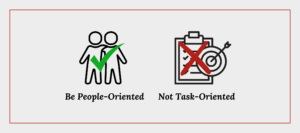
Pt. 1 – Carnegie to Current Day: The Do’s and Don’ts of Impactful Leadership in Justice
Dr. Mary Livers, Ph.D., is a national expert, consultant, trainer, and professor with a career spanning nearly 45 years specializing in adult and juvenile justice operations and leadership development. In today’s post, Mary revisits some of her favorite Dale Carnegie teachings, explaining how they impacted her career in justice and showing how they still ring true for today’s leaders and the aspirational leaders of tomorrow.

The first print of Dale Carnegie’s How to Win Friends and Influence People was in October 1936. 1936! Before World War I. The same basic principles about how you should treat people today are right here in this book.
Why Carnegie and Why Now?
You might be asking yourself, “Why Carnegie? And why now?” And that’s a fair question. Lord knows there have been countless influential voices on the topic of leadership that I could reference, many of them more current and modern than the infamous Dale Carnegie. But I believe there are certain traits to effective leadership that are truly timeless. They transcend the norms or trends of each era and form the bedrock of impactful, effective leadership. Carnegie’s teachings are just that – timeless, impactful, and simple to understand – and we could all use a refresher.
I came across Carnegie’s teachings the same way many first discover him – I was searching for answers. Not only did I find those answers but I found something even more powerful, my voice.
Mary Had a Little Lamb Fear of Public Speaking

I was the best imposter. Growing up, I went to any length possible to get out of speaking in front of others. Just picture grade school Mary, skillfully convincing her mother that this tragically flu-stricken child could simply, in no way, make it to school that day to present her book report.
Growing up, I was scared to death to speak in front of people. (A statement that those who know my strong-willed, outspoken self today, probably have a hard time believing. But it’s true.) So scared, in fact, that I spent most of my life in school trying to figure out ways of not being called on…of not raising my hand… of hiding in the back…
All through high school and into college and my early career I did the same thing (avoid, avoid, avoid!) but got even better at it. Despite my immense fear, I was really quite the leader. I liked to make decisions. I liked to be in charge; and I realized in high school that if I didn’t confront this massive fear of public speaking, I was going to limit my opportunities to be in a leadership role.
Not long into my career, while working as a superintendent of a community center, my fear reared its ugly head again. My boss informed me that I had to go to the legislature and make a speech in front of a large legislative forum and all of my colleagues. I was petrified. I literally begged my boss to not make me do it. I did end up doing it, but it would frighten me nearly to death. I could feel my knees shaking as I gave the speech. I finally said, “I have to do something about this.” One of my colleagues who knew of my struggle recommended signing up for Dale Carnegie’s speaking and development course. My agency paid for half and my parents paid the other half – talk about support! To say it changed my life would be a huge understatement.
Carnegie’s Teachings Today – Key Takeaways for Every Leader
Today, I revisit some of my favorite Carnegie concepts to show how they still ring true for today’s leaders and the aspirational leaders of tomorrow. Read along to hear the Do’s and Don’ts of leadership that I believe have stood the test of time, and how I’ve seen these teachings ring true throughout my career as a leader in the justice community.
1. On the Fundamentals of Handling People and Putting People First

The feedback I got from a lot of my colleagues over the years was that I was very task-oriented, and I had to really work at changing that. What I would recommend to leaders of today is, “People first.” If people would be honest about how they see me in the workplace, they’d say, “Well, you never have to worry about where you stand with her,” because I’m very direct and honest about what I see. I try to give feedback in a way that is helpful, not hurtful, but I do give feedback and direction. The following are a couple of tried-and-true approaches that have helped me improve my leadership style over my career by prioritizing people first:
Do Give Honest and Sincere Appreciation: Appreciation is one of the most powerful tools in motivating others.
Tip: Regularly acknowledge team members’ efforts and successes.
I think we need to keep in mind that people don’t hear ‘thank you’ enough. In our fast-paced societies, we take advantage of the good work that people do, and I do think ‘thank you’ goes a long way in recognizing people with just, “Good job. Thank you. I like the way you did that,” or”you’re really good at that.” It’s really very easy to do. And it’s powerful.
Don’t Condemn or Complain: harsh criticism is futile and dangerous as it puts a person on the defensive and usually makes them strive to justify themselves.
Tip: Provide constructive feedback instead of criticizing mistakes (praise in public, criticize in private!).
As powerful as sincere appreciation is, staff probably won’t remember your kind words as much as they will remember the times when you are critical of them. When you’re critical, and you condemn and complain, that hurts their heart. In my experience, staff remember critical feedback much more than they remember me giving them praise and appreciation. It’s just human nature. If you want staff to internalize their good points, give them frequent compliments, they go a long way.
As an example, when we start staff meetings, we should focus on people – be people-oriented and not task-oriented. Deal with people first and then address the task or next phase of what you need to do. When you start a staff meeting, begin with, “How was your week last week?”; “Let’s talk about what we did well last week…”; “Let’s talk about our wins last week…”; “Okay, now let’s talk about some things we could have done better in hindsight, because hindsight is 20/20. What can we learn from what we maybe didn’t do when we fell short?”
This approach allows you to begin the conversation on a positive, appreciative note by highlighting what the team has done well, and then enables you to transition the dialogue to a more issue-oriented, but productive discussion.
2. On Ways to Make People Like You

Do you need to be everyone’s favorite person to be a great leader? Of course not. But that’s not to say that being liked or likeable isn’t a valuable strength for any leader. There are many ways to accomplish this, but they all must start from a place of genuine intent. Try embracing the following:
Do Become Genuinely Interested in Other People: Show sincere interest in others to build lasting relationships.
Tip: Actively listen and engage with colleagues and staff about their interests and lives.
As I said, it starts with the leader genuinely caring about people, and genuinely caring about the team; not just caring about the task or the goal but caring about how you’re supporting them. That’s what leaders do – support the members of the team so they can do their best work.
If you don’t care about people, you shouldn’t be in a leadership position. Staff know whether you care about them or not. We should know our staff by name and know a little bit about their family life and a little bit about their background; a little bit about what they like, what they don’t like. That’s important to people. This certainly applies to the immediate team of people that you work with and perhaps even beyond that to other circles in the organization.
Do Pay Attention to Your Body Language: A simple smile can break down barriers and make others feel more at ease.
Tip: Your mood sets the tone for the mood of your staff, so be intentional with a warm greeting, smile, and/or welcoming body language.
A smile seems friendly and helps people sort of settle down – but it doesn’t, and shouldn’t, stop there. There are other body language aspects that we need to pay attention to. For instance, when somebody walks into your office, and you invite them to sit down, why not come back around your desk and sit down with them? Have a more personal conversation. At the very least, don’t slump back in your chair and start looking at everything else on your desk and not really listen. This person came in here to share something that was important to them – show them you recognize that and give them the time and attention they deserve.
Do Remember That a Person’s Name Is, to That Person, the Sweetest Sound in Any Language: Use names to personalize interactions and build camaraderie.
Tip: Use names frequently in conversation to show attentiveness and respect.
Remembering and using a person’s name is a simple yet powerful way to make a positive impact as a leader. It shows attentiveness, respect, and recognition, which are essential for building trust and respect within a team. When you address someone by name, it personalizes the interaction and makes the individual feel valued and acknowledged. This small gesture can significantly enhance communication, foster a sense of belonging, and strengthen relationships. By consistently using names in conversations, you demonstrate genuine interest in your team members, boosting morale and creating a more cohesive and motivated work environment.
In the end it’s about cultivating good personal habits that communicate that “you matter”; that somebody else on the team matters, and that you’re listening. People just want to be heard.
3. On Winning People to Your Way of Thinking

The biggest problem with arguments is there seems to be a winner and a loser. Whenever possible, you want to avoid situations where it’s a win/lose, but nobody wins really. Somebody may win the argument, but the other person feels slighted. Carnegie emphasizes that there are much better ways to handle disagreements – start by trying to find common ground and utilizing the tactics below:
Do Show Respect for the Other Person’s Opinions. Don’t Say, “You’re Wrong.”
Tip: Phrase disagreements in a way that respects the other person’s viewpoint, such as, “I see it differently because…”
Ideally, it’s best to not find yourself in a position where you’re either having to referee an argument or you’re an actor in an argument. That takes discipline, particularly if you’re passionate about issues, and I tend to be passionate. I wish I was better at this particular thing than I actually am, but I recognize that it’s important.
When you do find yourself in a potentially argumentative situation, anything you can do to find common ground with someone will put you in a much better position than trying to debate them on who’s right or wrong. When faced with an adverse opinion or difference stance, try responding with “I think you’re saying…”;”I agree with that…”; “I think what you just said is something I really believe, too.” Find as much common ground as you can and focus on starting there, as opposed to creating this ‘right/wrong,’ ‘win/ lose’ sentiment.
Do Openly Admit When You are Wrong – Admit It Quickly and Emphatically: Owning up to mistakes builds trust and respect.
Tip: Leaders should openly admit their own errors in team meetings.
Leaders in civic and justice facilities must create an environment where admitting mistakes is seen as a strength rather than a weakness. To do so, you yourself must be humble. You must be willing to say, “You know, I saw that wrong. I used all the information I had available to me, and I made the wrong call.” I have done that because I have made mistakes. I do make mistakes. The best thing you can do is admit it and take ownership, take responsibility for it. Don’t blame anybody else. Leaders should always take responsibility. It’s really a way to be empowered, “I own that. That was my error. This is how I’m going to fix it…” Once you take responsibility, that gives you the power to change it. You’re not a victim.
More to Come – Stay Tuned for Part Two
As we wrap up part one of our deep dive into Dale Carnegie’s timeless leadership principles, it’s clear that his advice remains as relevant today as ever. From improving our approach to handling people to building genuine connections and winning others to your way of thinking, these foundational skills are essential for any leader and have helped me immensely over the course of my career in justice. None of us are perfect leaders and none of us are immune to making mistakes. But as leaders, we need to strive for excellence and do the very best we can to be the best leaders we can – we owe that to our staff and our organizations.
In part two, we’ll delve into how to lead without causing resentment, manage stress effectively, and achieve your goals and your team’s goals with a positive mindset. Stay tuned for more actionable insights and practical tips to enhance your leadership journey.




